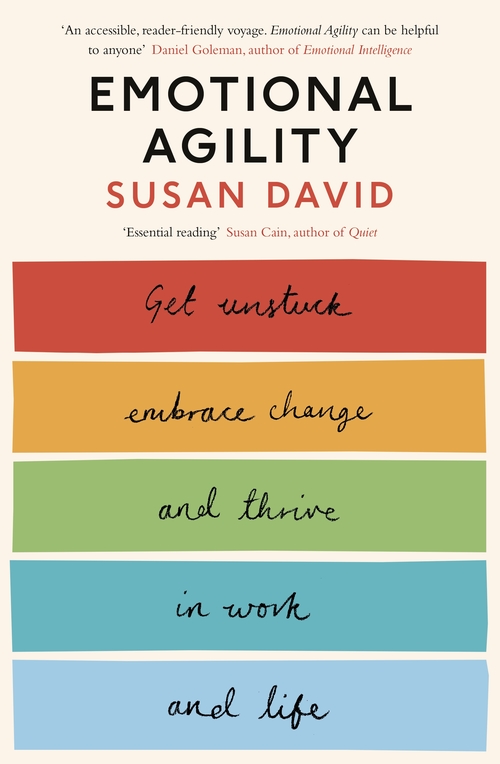When one’s mental health is unstable, one grabs at self-help books that one thinks might improve one’s situation. My last grab was Emotional Agility: Get Unstuck, Embrace Change and Thrive in Work and Life, by Susan David, Avery, 2016.
I first found out about the book by watching a TedTalk (https://www.ted.com/talks/susan_david_the_gift_and_power_of_emotional_courage) given in 2017. I liked the talk so much that I decided to read Susan David’s book.
I started reading the book then found that I really wanted to understand it better, so went back to the beginning and made hand-written notes. I find that helps me understand the material better. It also allows reflection on what I am reading so that I don’t race so fast through the book that I have forgotten everything by the end. This blog is also helping me understand the material better and what the next step for myself should be. I hope the blog will also encourage you to read the whole book for yourself. My summary does not give all the examples that makes the theory come to life.
I felt that one chapter a day was about right. I needed to digest the ideas in one chapter, perhaps practice something in my own life, before going on to the next one.
Here are the names of the chapters with a short summary of the topic, taken from my notes, and often direct quotes from the book though I have not given the page references.
Chapter 1: Rigidity to Agility – Emotions are the body’s immediate, physical responses to important signals from the outside world. Emotions are our natural guidance system and should not be fought. We need to become more aware of our emotions (including setting the right name to them), accept them and use them to grow. Sometimes emotions dredge up old business, confusing our perception of what is happening in the moment with painful, past experiences. We need to become more agile while accepting our emotions. Flexibility with thoughts and feelings will help us to respond optimally to everyday situations and is a key to well-being and success.

Susan David lists four steps in emotional agility:
- showing up and facing your thoughts, emotions and behaviours willingly, with curiosity and kindness
- stepping out and detaching ourselves from our emotions and thoughts, and observing them to see them for what they are
- walking your why and focusing more on what your core values are or your most important goals
- moving on by making small changes one at a time and getting a balance between challenge and competence.
Chapter 2: Hooked – The human mind is a meaning-making machine and it likes to create a cohesive narrative. We all take liberties with the truth. Our internal voice is a chatterbox and may be biased, confused, engaged in wilful self-justification or even deception. Many of our responses to daily situations are reflexive, as if we are on autopilot, and we become hooked on rules of thumb (or heuristics) that are inappropriate. People who are “hooked” into a particular way of thinking and behaving are not really paying attention to the world as it is. Being emotionally agile means being sensitive to context and responding to the world as it is right now.
Chapter 3: Trying to Unhook – Positive emotions drive us to success, help us make better decisions, reduce the risk of disease and allow us to live longer. Negative emotions encourage slower, more systematic cognitive processing, such as forming arguments, improving memory, encouraging perseverance, making up more polite and attentive, encouraging generosity, and making us less prone to confirmation bias. Note that what are considered “negative” emotions can actually have a positive effect on us.
The author divides people into three groups, bottlers, brooders and those who are emotionally agile. Bottlers push emotions to the side and get on with things, but ignoring emotions doesn’t get at the root of whatever is causing them. The suppressed emotions inevitably surface in unintended ways. Brooders stew in their own misery, endlessly stirring the pot around and can’t let go of the emotion. They are inhabiting a moment that is not now and constantly looking back in time, often blaming themself. Neither of these types helps a person to become emotionally agile.
Chapter 4: Showing Up – Movement towards a better life begins with showing up, facing up to our demons, making peace with them, and finding an honest and open way to live with them. We can’t change ourselves or our circumstances until we accept what exists right now. We need to use words to define and understand our experiences and the emotions surrounding them. Compassion for ourselves gives us the freedom to redefine ourselves, as well as the all-important freedom to fail. When you are emotionally agile, you don’t waste energy wrestling with your impulses. You simply make choices that are connected to what you value.
Chapter 5: Stepping Out – Writing helps process experiences. It helps you step out from inertia and into meaningful action. There is a need to create distance between the thinker and the thought, between the feeler and the feeling. We must separate ourselves from our experiences and see them from a different perspective. The author brings into her work the concept of mindfulness which is a way of helping us focus, allowing us to notice uncomfortable feelings and thoughts and getting us more comfortable with our inner essence. It is important to let go of past experiences, expectations, or perhaps a relationship. Forgiving oneself and others can also be part of the process.
Chapter 6: Walking Your Why – Identifying and acting on the values that are truly your own is the next step. It is living by the beliefs and behaviours that you hold dear and that give you a sense of meaning and satisfaction. Taking time for the long view leads to actions that benefit the long term and you will more likely be comfortable with who you are. These personal values must be freely chosen and are not goals, but allow you to get closer to the way you want to live your life. They are beliefs that give you freedom from social comparisons and are something that you use. Spending time reflecting on what matters to me, what I want my life to be about and what new things I want to pursue, can help me make choices that move me towards my values and act like the person I really want to be.
Chapter 7: Moving On: The Tiny Tweaks Principle – Tweaking the little things allows us to align our behaviour more closely with what really matters. Small changes over time can dramatically enhance our ability to thrive. Here Susan David brings in the concept of mindset, whether we think our abilities are fixed, or whether we think of ourselves as growing, learning individuals. People who have a growth mindset and who see themselves as agents in their own lives are more open to new experiences, are more willing to take risks, are more persistent and more resilient in rebounding from failure. We can also tweak our motivation by doing what we “want to”, not what we “have to”. We can tweak our habits by taking consciously chosen behaviour and turning it into a habit, so that it can persist over time with almost no further effort.
Chapter 8: Moving On: The See-Saw Principle – When we get too good at something, it leads to complacency. When complacent we use auto-pilot mode so that rigid behaviours are reinforced and we become disengaged from what is happening. Everything becomes routine and there is no challenge, joy or discovery. On the other hand, if we face a task that is too difficult for us, we get stressed and that prevents our ability to be creative. The see-saw principle means that we must maintain a balance between over-competence and over-challenge. We want to incrementally advance ourselves beyond the level of our competence and comfort, but in small tweaks. We constantly need to expand what we do, the skills we acquire, the topics we talk about and the avenues we explore. We need to expand how well we do what we do, the quality of our listening and the level of our engagement with the world.
Chapter 9: Emotional Agility at Work – In this chapter, the author gives several examples of people who are not functioning well in their jobs and tries to show how using emotional agility would have made a difference. The previous chapters were about how to make changes, and this chapter shows how to use these principles on the job.
Chapter 10: Raising Emotionally Agile Children – We often underestimate a child’s ability to learn and grow from experiences and mistakes. Helping children acknowledge the emotion, examine the why and focus on the process will give them life-long skills. Here are some good tips for those who have children.
Chapter 11: Conclusion: Becoming Real – This chapter is really just a short summary of the rest of the book and restates that emotional agility allows us to be our authentic selves, for everyone, everyday.
I liked the author’s style of writing, with relevant examples of people who have made mistakes and how they need to be worked on. The reader must make up their own mind what their personal values will be, but the author gives us some guidelines on how to work with our own personal values to make our lives more in tune with our values.
Boken som jeg beskriver her er forholdvis ny og jeg kan ikke se at den er oversatt til norsk. Jeg anbefaler boken. Litt om innholdet.
Forfatteren er psykolog og har arbeidet med følelser. Følelser er kroppens reaksjon til viktige signaler fra omverdenen. Følelser er vårt naturlig styresystem og skal ikke motarbeides. Vi må bli bedre klar over våre følelser, blant annet å sette riktig navn på dem, godta dem og bruke dem til å vokse som menneske. Noen ganger vil følelser bringe til overflaten gamle ting som forvirrer våre oppfattelse av det som skjer nå. Vi må bli smidiger og godta våre følelser. Fleksibilitet med tanker og følelser vil hjelpe oss til å reagere optimalt til hverdags situasjoner og er nøkkelen til trivsel og suksess.
Det er fire trinn til emosjonelle smidighet:
- En må dukke opp og møte tanker, følelser og atferd, villig og med nysgjerrighet og vennlighet.
- En må løsrive seg selv fra disse tanker og følelser, og se på dem som hva de er
- En må fokuser på sine egne kjerneverdier og la dem styrer hva du gjør
- En må gå videre ved å lage små endringer og få til en balanse mellom utfordinger og kompetanse.
For de som vil ha den korte versjonen av boken, kan du se denne TedTalk gitt i 2017: https://www.ted.com/talks/susan_david_the_gift_and_power_of_emotional_courage

Today, I started reading an article today, that offers some of the same advice as Susan David, but condensed: https://www.inc.com/justin-bariso/13-things-emotionally-intelligent-people-do.html
While this subject is interesting, I am struggling to read more than 10 consecutive pages in a day. I am not quite sure why, although I have suspicions. Manfred Spitzer explains in Digitale Demenz, we are addicted to digital media. I am finding much of the same content in Adam Alter’s Irresistible: The Rise of Addictive Technology and the Business of Keeping Us Hooked.